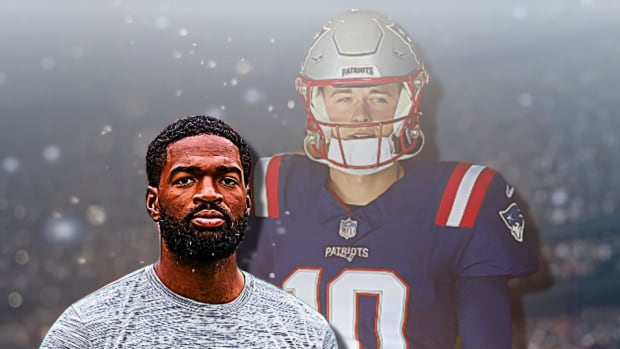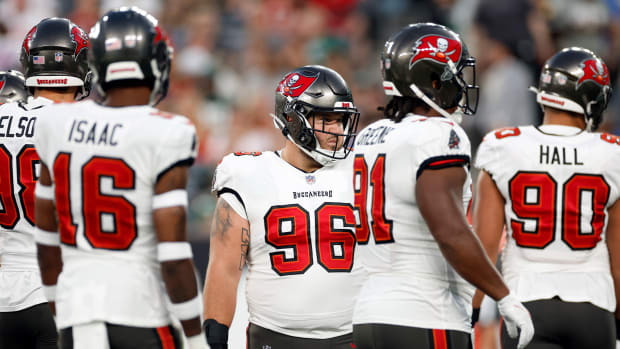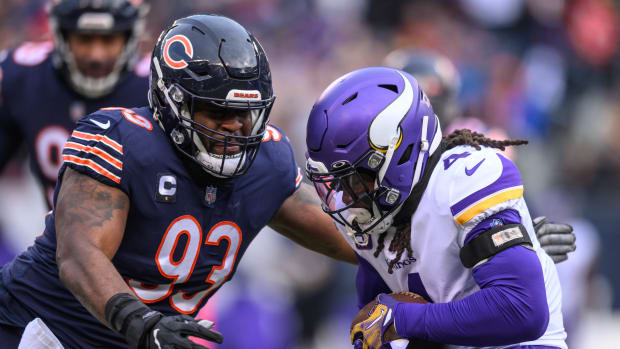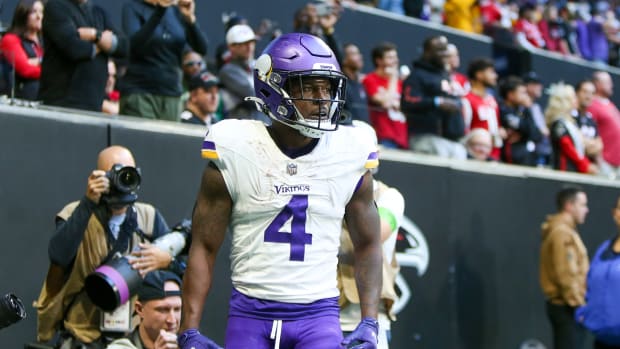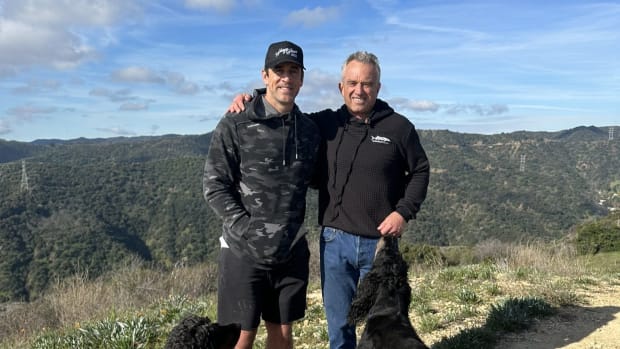Colts' Flexibility With Eason, Who Eagles Would've Taken Besides Jalen Hurts, Draft Notes
Some more wrap-up work with the draft in the rear-view mirror …
• The round the Colts took Jacob Eason in is important in the grand scheme of their future quarterback plans. Why? Because getting the Washington product in the fourth allows them to throw a dart at the position without any opportunity cost. Eason will get a year to develop under Frank Reich and Nick Sirriani, Philip Rivers and Jacoby Brissett will play out contract years, and then Indy can reassess after the 2020 season. Eason’s shown over the last few years, at two different schools, that he has plenty of growing up to do, something that led NFL teams to question how much he really loves football. That said, his potential is immense, and getting to learn to be a pro should be easier alongside Rivers and Brissett. And putting Eason in that environment should also help the Colts get answers quicker on whether the light will turn on for the 22-year-old.
• I’ve got a couple of fun notes on the Eagles’ vetting of Oklahoma QB Jalen Hurts, which provided the runway for his selection as the 53rd pick on Friday. One, VP of player personnel Andy Weidl actually got live exposure to Hurts in game action—he was on site for the Sooners’ 52–14 beatdown of West Virginia. Hurts threw for 316 yards and three touchdowns on 16-of-17 passing, and his only incompletion came on a drop by Drake Stoops (yup, Bob’s son); and he rushed for 75 yards and two more touchdowns on 10 carries. Two, pass-game coordinator Press Taylor was on site for Oklahoma’s pro day on March 12, which took place just before the scouting circuit was shut down, and gave Philly another data point to work off. Obviously, both of those guys had positive impressions. And again, I think the main argument here is how high Hurts was picked, given that the Eagles just gave their young franchise quarterback a top-of-the-market deal. Only time will tell us the rest of the story. And if you want something to track coming out of all this: Southern Illinois S/LB Jeremy Chinn (Panthers) and Ohio State RB J.K. Dobbins (Ravens) were two players I’d heard would’ve been under consideration, had Hurts not been the pick at 53. Gun to my head, I say Philly would’ve taken Chinn in that circumstance.
• For what it’s worth, I believe the Texans would’ve taken TCU DT Ross Blacklock—a twitchy, athletic force with strong character—at 26, had they not made the deal for Laremy Tunsil with that pick. As it was, he was clearly their top guy going into Day 2, ranked only behind Auburn’s Derrick Brown and South Carolina’s Javon Kinlaw among all the interior defensive linemen on Houston’s board, and they got him at 40, the pick acquired in the DeAndre Hopkins trade. Should that change how you view the Tunsil trade vs. the Hopkins trade? Maybe not. But I’d say if they got the same player at one spot (40) that they would’ve at the other (26) that contextualizes everything a little. Coach Bill O’Brien has said repeatedly that he sees this, because of the pandemic, as the sort of year where veterans are going to be important. He should hope so, given that the team used picks this year to acquire Tunsil, Gareon Conley and Duke Johnson (the latter two became new Patriots TE Devin Asiasi and new Browns LB Jacob Phillips, the 91st and 97th picks).
• The Chiefs’ drafting of Clyde Edwards-Helaire was, in fact, a convergence of a few different puzzle pieces coming together. First, there was the team’s quiet internal concession that it’s needed a bellcow back since losing Kareem Hunt 17 months ago. Second, the draft fell in a way where some other need spots were picked clean by the time the Chiefs got on the clock at 32 (linebacker would be one, with Kenneth Murray, Patrick Queen and Justyn Brooks gone). And third, and this was the most important part, Kansas City fell in love with Edwards-Helaire’s game. Before every draft, GM Brett Veach and his staff give coach Andy Reid and his staff pockets of players to assess at every position, in an effort to marry up scouting reports from both sides of the operation. What the scouts got back from the coaches, from Reid to offensive coordinator Eric Bieniemy to RBs coach Deland McCullough, was unanimous, and lined right up with what the scouts were saying (Veach told Reid he believed Brian Westbrook was a fair comp just before Reid did the work on Edwards-Helaire). And that made it fairly simple picking Edwards-Helaire in front of about a half-dozen other guys the Chiefs would’ve been OK with at the position.
• One thing that made the Cardinals comfortable with Clemson LB Isaiah Simmons: The intel they got back from the school showed that Simmons would switch position-group rooms on a weekly basis during the season, depending on how DC Brent Venables planned to use him in a given game. That doesn’t sound like a huge deal, but it takes a certain mental capacity to toggle like that, and it sure made Arizona believe that Simmons’s transition to the NFL should be a smooth one. They see him as the ultimate matchup guy, big and physical enough to cover tight ends, fast enough to run with slots, and able to rush and play him off the hash. The one thing you got going into the draft was that pigeonholing him in one spot as a pro would be wasting his talent. Rest assured, he will not be strictly a box defender in Arizona.
• As the Trevor Lawrence Derby gets set to leave the starting gates, let’s try and remember one thing: No matter how much 2021 capital you compile, you’re almost certainly going to have to be the worst team in football to get him. Whoever has that pick is very close to a sure thing to take a player who’s been compared, as a prospect, to Peyton Manning. And that even goes for certain teams with good young quarterbacks, and I’ve actually got a story on that one. You may remember, the Rams were in the running to get the first pick right up until the end of Steve Spagnuolo’s last year in 2011, but wound up getting the second pick, which they dealt to Washington for three first-rounders and a second-rounder. Had they landed the first pick? I’ve been told consistently over the years they’d probably have kept it, taken Andrew Luck and traded Sam Bradford, who they had taken first overall two years early. Luck was a generational prospect, of course. So is Lawrence.
• Perhaps the biggest shocker of Round 1 was Las Vegas taking Damon Arnette 19th overall, with Arnette having been projected widely as a Day 2 player. And part of how this all went down was purely logistical. I talked with a couple of guys who’ve known and worked with Arnette over the years right before the draft, and one was adamant that the Raiders were smitten with the corner and would try and move down to position themselves to take him. Las Vegas, I’m told, did try. But a good enough offer never materialized and that put GM Mike Mayock in a weird spot. He could either draft Arnette higher than most valued him at 19 or, without another pick until the middle of the third round (80th overall), miss out on him altogether. So Mayock, as we’ve seen him do a number of times over his 15 months in charge, trusted his evaluation, gritted his teeth and took Arnette at 19.
• I asked Chargers coach Anthony Lynn how he and GM Tom Telesco came to a decision to spend the sixth pick on a quarterback, and I thought his answer was telling. “It just made sense,” Lynn said. “Losing a franchise guy, a guy that’s been the guy here for 15, 16 years, and picking sixth? Hell, I don’t want to ever be picking sixth again. So if I’m already picking this high, and there’s a quarterback we like, we might as well just get the quarterback now. We knew Phil was towards the end. And you say the end, Tom Brady’s 43—these guys are playing until they’re senior citizens. We felt like with the crop that was coming out this year, this would be the time to get a young quarterback in here, and even if Phil was here, he could sit behind Phil for a year or two and learn.” The important part? I don’t ever want to ever be picking sixth again. My sense is for both the Dolphins and Chargers, the time had to be now, because they believe they’ll be too competitive next year to be able to count on drafting the one they want in 2021.
• Here’s the cap space for 10 teams that’ll have trouble making many more changes: Rams ($419,169), Patriots ($1.077M), Falcons ($2.233M), Saints ($3.855M), Bucs ($4.364M), Chiefs ($4.912M), Seahawks ($5.257M), Steelers ($5.768M), 49ers ($6.767M) and Panthers ($7.008M). And the cap space for 10 teams who should be able to augment: Browns ($37.548M), Washington ($36.694M), Lions ($29.488M), Broncos ($24.249M), Colts ($24.068M), Eagles ($23.540M), Titans ($21.609M), Chargers ($20.995M) Bills ($20.596M) Dolphins ($20.174M). This is especially relevant now that free-agent signings no longer count against the comp-pick formula, which means teams that have been relatively dormant to protect their 2021 draft haul can now freely move about the market.
• I also would think we’ll see continued movement of some veteran players in the coming days. Some teams held back on cutting guys, thinking teams might make trades later in the process, given how hard it will be to assimilate rookies this year. But with the draft having come and gone, a lot of those players will now be cut. Seahawks linemen Justin Britt and D.J. Fluker would be two examples. And keep an eye on Bengals QB Andy Dalton in the coming days. He could be another.
• Question or comment? Email us.

































